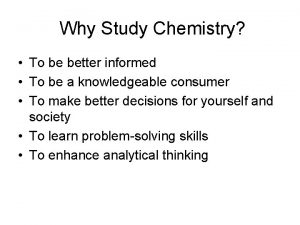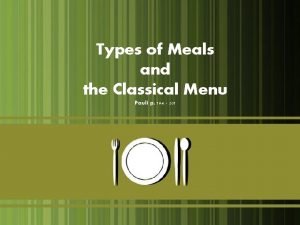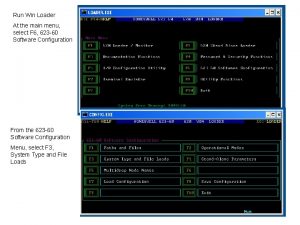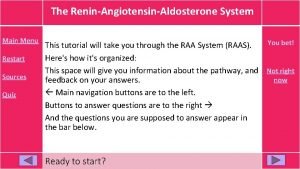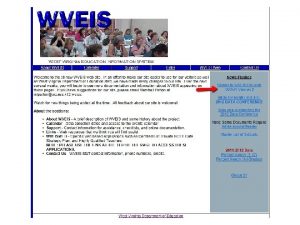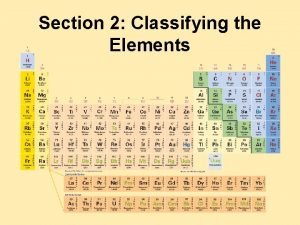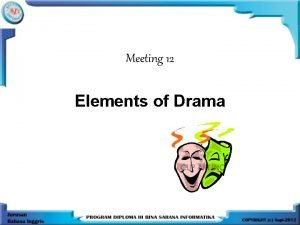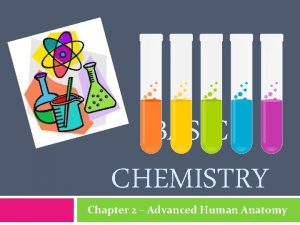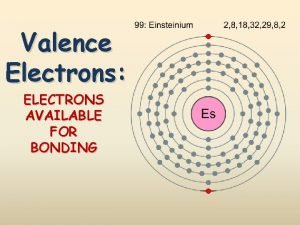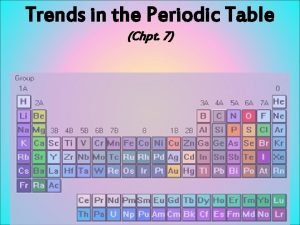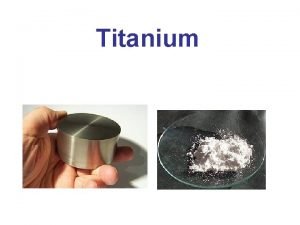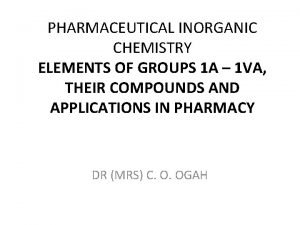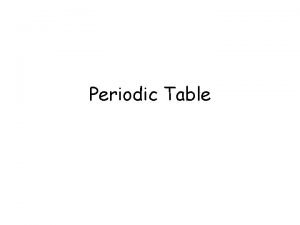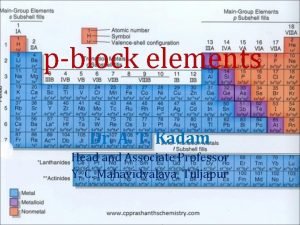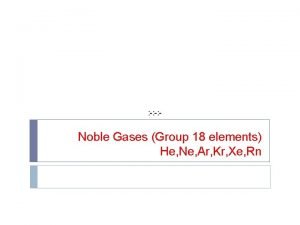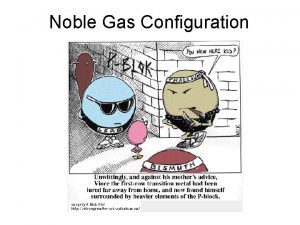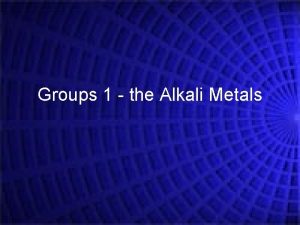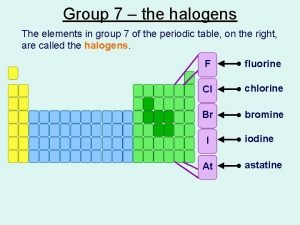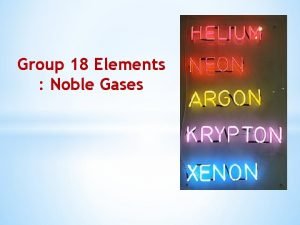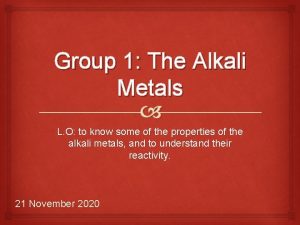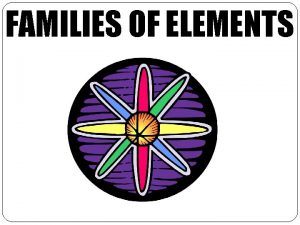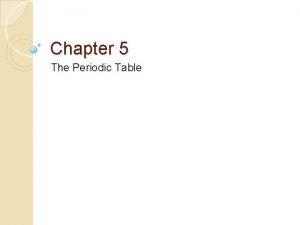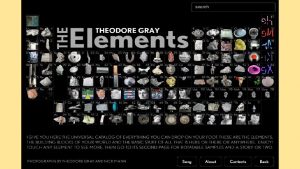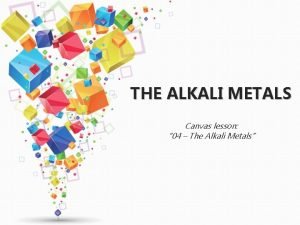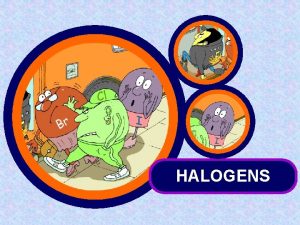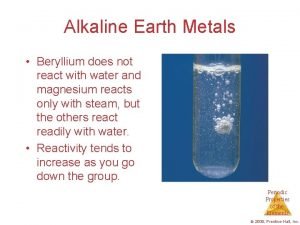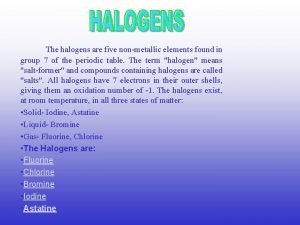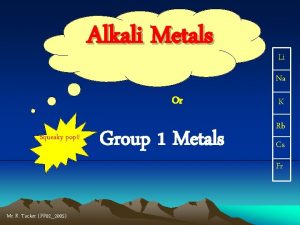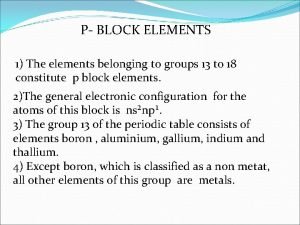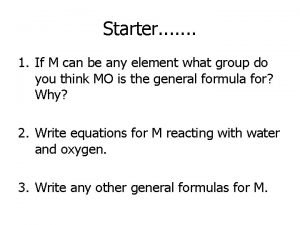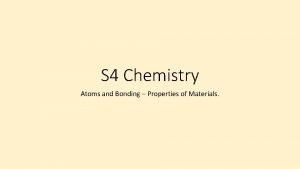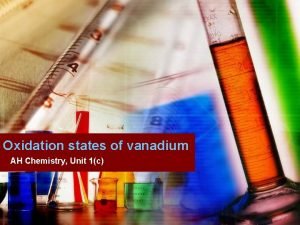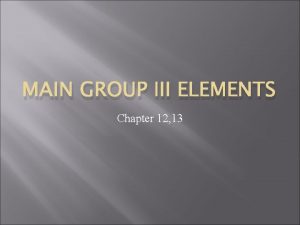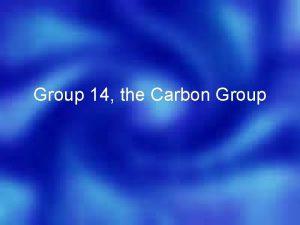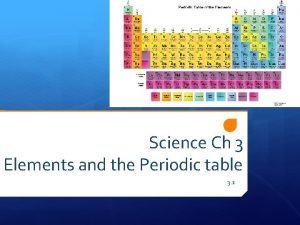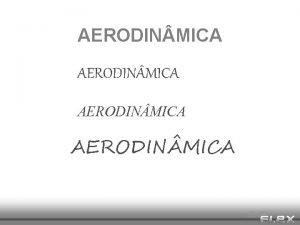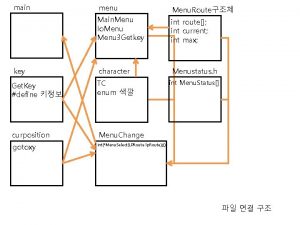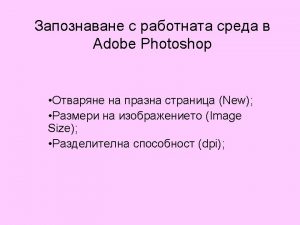Chapter Menu Section 8 1 Main Group Elements










































































- Slides: 74


Chapter Menu Section 8. 1 Main Group Elements Section 8. 2 Transition Elements Click a hyperlink to view the corresponding slides.

Main Group Elements • Relate the position of main group elements on the periodic table to their electron configurations. • Predict the chemical behaviors of the main group elements. • Relate chemical behavior to electron configuration and atomic size.

Main Group Elements inner transition element: one of the elements in the actinide or lanthanide series

Main Group Elements alkali metal alkaline earth metal halogen For the main group elements, both metallic character and atomic radius decrease from left to right across a period.

Patterns of Behavior of Main Group Elements • Elements in the same group have similar properties because they have the same number of valence electrons. • Elements in the same period have different properties because the number of valence electrons increases as you move from left to right in the row of the periodic table.

Patterns of Behavior of Main Group Elements (cont. )

Patterns of Behavior of Main Group Elements (cont. ) • Atomic radius is defined as one-half the distance between the nuclei of two identical atoms when those atoms are bonded together. • With each increase in nuclear charge across the period, the outer electrons are attracted more strongly toward the nucleus, resulting in smaller atomic size.

Patterns of Behavior of Main Group Elements (cont. )

Patterns of Behavior of Main Group Elements (cont. )

Patterns of Behavior of Main Group Elements (cont. ) • Atomic size is an important factor in the chemical reactivity of an element. • Ionic size is also important in determining how ions behave in solution and the structure of solid ionic compounds.

Patterns of Behavior of Main Group Elements (cont. )

Patterns of Behavior of Main Group Elements (cont. ) • Electrons that are not lost experience a greater attraction to the nucleus and pull together in a tighter bundle with a smaller radius. • When an electron is added, the charge on the nucleus is not great enough to hold the increased number of electrons as closely as it holds the electrons in the neutral atom.

Patterns of Behavior of Main Group Elements (cont. )

Patterns of Behavior of Main Group Elements (cont. ) • Ionic radii decrease because nuclear charge increases.

Patterns of Behavior of Main Group Elements (cont. ) • Elements tend to react in ways that allow them to achieve the configuration of the nearest noble gas.

The Main Group Metals and Nonmetals • Group 1 elements are called the alkali metals. – They lose their s valence electron and form a 1+ ion with the stable electron configuration of the noble gas in the preceding period. – The most reactive alkali metal is the one that has the least attraction for this electron.

The Main Group Metals and Nonmetals (cont. ) • Group 2 elements are called the alkaline earth metals. – They lose their s valence electrons and form a 2+ ion with the stable electron configuration of the noble gas in the preceding period. – Group 2 elements are less reactive than group 1 elements because they lose 2 electrons.

The Main Group Metals and Nonmetals (cont. ) • Group 13 elements – tend to share electrons in covalent compounds rather than form ionic compounds – Their valence configuration is s 2 p 1, and they exhibit the 3+ oxidation number in most of their compounds.

The Main Group Metals and Nonmetals (cont. ) – Aluminum is the most abundant metallic element in Earth’s crust. – Unlike the other group 13 elements, boron is a metalloid.

The Main Group Metals and Nonmetals (cont. ) • Group 14 elements – usually share electrons rather than lose electrons to achieve a noble gas configuration – Their valence configuration is s 2 p 2, and they exhibit the 4+ oxidation number in most of their compounds.

The Main Group Metals and Nonmetals (cont. ) • Group 15 elements – form covalent bonds to achieve noble gas configuration – Their valence configuration is s 2 p 3.

The Main Group Metals and Nonmetals (cont. ) • Group 16 elements – form covalent bonds to achieve noble gas configuration – Their valence configuration is s 2 p 4. – Both metals and nonmetals react directly with molecular oxygen to form oxides.

The Main Group Metals and Nonmetals (cont. )

The Main Group Metals and Nonmetals (cont. ) • Group 17 elements are called halogens. – active nonmetals that don’t exist freely in nature – Their valence configuration is s 2 p 5. – form – 1 ion with a noble gas configuration

The Main Group Metals and Nonmetals (cont. ) – Because the halogens react by gaining an electron, the most reactive element in the group is the one with strongest attraction for an electron.

The Main Group Metals and Nonmetals (cont. ) • Group 18 elements are the noble gases. – no tendency to lose or gain electrons – lack of reactivity

Section Assessment Atomic radius is defined as ___ the distance between the nuclei of two identical atoms when those atoms are bonded together. A. one-fourth B. one-half C. twice D. three-fourths

Section Assessment Elements in the same period have similar properties because they have the same number of valence electrons. A. true B. false


Transition Elements • Relate the chemical and physical properties of the transition elements to their electron configurations. • Predict the chemical behavior of transition elements from their positions in the periodic table.

Transition Elements halogen: an element from group 17 (F, CI, Br, I, and At) that reacts with metals to form salts The properties of the transition elements result from electrons filling d orbitals; for the inner transition elements, electrons fill f orbitals.

Trends in Properties • Each of the transition elements has its own properties that result from its atomic structure. • With the exception of the group 12 elements, the transition metals have higher melting points and boiling points.

Trends in Properties (cont. ) • There is a wide range of oxidation numbers within the transition elements due to the involvement of the d electrons in chemical bonding. • The changes in atomic radii for the transition elements are not as great as the changes for the main group elements.

Other Transition Elements: A Variety of Uses • Iron, cobalt, and nickel have nearly identical atomic radii, similar chemical properties, and are known as the iron triad.

Other Transition Elements: A Variety of Uses (cont. ) • The platinum group includes ruthenium, rhodium, palladium, osmium, iridium, and platinum. They are used as catalysts to speed up chemical reactions.

Other Transition Elements: A Variety of Uses (cont. ) • The coinage metals are copper, silver, and gold. They are malleable, relatively unreactive, and in the case of silver and gold, rare.

Other Transition Elements: A Variety of Uses (cont. ) • Chromium and zinc are corrosion-resistant metals that are often alloyed with other metals to protect them.

Other Transition Elements: A Variety of Uses (cont. )

Lanthanides and Actinides: The Inner Transition Elements • The inner transition elements are found in the f block of the periodic table. • In the lanthanides, electrons of highest energy are in the 4 f sublevel.

Lanthanides and Actinides: The Inner Transition Elements (cont. ) • In the actinides, electrons of highest energy are in the 5 f sublevel. • Cerium is the most abundant lanthanide and used to make the flints for lighters. • The actinide uranium is a naturally occurring, radioactive element used as a source of nuclear fuel and other radioactive elements.

Section Assessment Which element is the most abundant lanthanide that is used to make flints for lighters? A. cerium B. uranium C. plutonium D. terbium

Section Assessment Which element is often used to prevent metals from corroding? A. nickel B. platinum C. chromium D. iron


Chemistry Online Study Guide Chapter Assessment Standardized Test Practice Image Bank Concepts in Motion

Key Concepts • In a period of the periodic table, the number of valence electrons increases as atomic number increases. • From left to right across a period, atomic radius decreases. Down a group, atomic radius increases. • The metal with the biggest atom and smallest number of valence electrons is the most active metal. • The nonmetal with the smallest atom and greatest number of valence electrons is the most active nonmetal.

Key Concepts • Transition elements form the d block of the periodic table. • Multiple oxidation states are characteristic of transition elements. • Transition elements with similar atomic radii often have similar chemical properties. The iron triad, platinum group, and coinage metals are examples. • The inner transition elements, the lanthanides and actinides, form the f block of the periodic table.

Ionic radii decrease because the: A. nuclear charge increases B. nuclear charge decreases C. atomic size increases D. atoms are covalently bonded

Elements tend to react in ways that allow them to achieve the configuration of the nearest ___. A. nonmetal B. metalloid C. noble gas D. metal

Which is the least reactive of the alkali metals in group 1? A. cesium B. francium C. rubidium D. lithium

Which metal of group 13 is a metalloid? A. boron B. aluminum C. gallium D. thallium

Which is the most abundant element on Earth? A. hydrogen B. oxygen C. nitrogen D. aluminum

Which is the least reactive of the halogens? A. fluorine B. iodine C. selenium D. chlorine

Which elements are known as the iron triad? A. iron, cobalt, and nickel B. iron, ruthenium, and osmium C. iron, nickel, zinc D. manganese, iron, and nickel

Which group of elements is often used to speed up chemical reactions? A. noble gases B. iron triad C. platinum group D. coinage metals

Which actinide is a naturally occurring, radioactive element used as a source of nuclear fuel and other radioactive elements? A. platinum B. uranium C. cerium D. lithium

Which region in the periodic table are the most reactive metals located? A. s B. f C. p D. d

Click on an image to enlarge.














Table 8. 0 Alloy Steels Figure 8. 3 Trends in atomic radii

To use this Interactive Chalkboard product: Click the Forward button to go to the next slide. Click the Previous button to return to the previous slide. Click the Home button to return to the Chapter Menu. Click the Return button in a feature to return to the main presentation. Click the Exit button or press the Escape key [Esc] to end the slide show. Click the Help button to access this screen. Click the Chapter Resources button to view available resources for the chapter. These resources include Chemistry Online, Study Guide, Chapter Assessment, Standardized Test Practice, Image Bank, and Concepts in Motion pieces can also be accessed on relevant lecture note slides.

This slide is intentionally blank.
 Is milk macroscopic microscopic or particulate
Is milk macroscopic microscopic or particulate Contoh pola menu
Contoh pola menu Fungsi menu microsoft excel
Fungsi menu microsoft excel Difference between classical menu and modern menu
Difference between classical menu and modern menu Bagaimana cara menjalankan browser mozilla firefox
Bagaimana cara menjalankan browser mozilla firefox Menu pull down exit terdapat pada menu..
Menu pull down exit terdapat pada menu.. Healthy main course menu
Healthy main course menu Winloader
Winloader Main menu
Main menu Jmenu tutorial
Jmenu tutorial Front and main menu
Front and main menu Arti back to main menu
Arti back to main menu Eway bill system main menu
Eway bill system main menu Wow change login screen
Wow change login screen Chapter 6 chemistry in biology
Chapter 6 chemistry in biology Chapter 6 section 1 atoms elements and compounds
Chapter 6 section 1 atoms elements and compounds Chapter 10 section 1 meiosis
Chapter 10 section 1 meiosis Tombol perintah charts terdapat pada menu ....
Tombol perintah charts terdapat pada menu .... Expressing future
Expressing future Main idea and supporting details
Main idea and supporting details Void main int main
Void main int main Is uranium a main group element
Is uranium a main group element Casemix main group adalah
Casemix main group adalah Casemix main group adalah
Casemix main group adalah Whats a main group element
Whats a main group element Main clause definition
Main clause definition Performance elements
Performance elements Elements of drama character
Elements of drama character Key element of short story
Key element of short story Three main elements of traditional model of science
Three main elements of traditional model of science Group polarization
Group polarization Within group variance vs between group
Within group variance vs between group Anova within group and between group
Anova within group and between group Characteristics of social groups
Characteristics of social groups Group 2 specialties
Group 2 specialties Thermal stability of group 2 nitrates down the group
Thermal stability of group 2 nitrates down the group Amino group and carboxyl group
Amino group and carboxyl group Amino group and carboxyl group
Amino group and carboxyl group In group out group
In group out group Group yourself or group yourselves
Group yourself or group yourselves William graham sumner in group out group
William graham sumner in group out group Joining together group theory and group skills
Joining together group theory and group skills Alkaline earth metals lewis dot structure
Alkaline earth metals lewis dot structure Group 7 elements properties
Group 7 elements properties Titanium group elements
Titanium group elements Nuclear charge definition
Nuclear charge definition Symbols for oxygen
Symbols for oxygen Group 13 elements
Group 13 elements Group 18 elements
Group 18 elements Group 8 elements
Group 8 elements Elements in group 1
Elements in group 1 Chlorine group
Chlorine group Inert gases properties
Inert gases properties Reaction of alkali metals with water
Reaction of alkali metals with water Alkali earth metals properties
Alkali earth metals properties Group 8 elements
Group 8 elements Group 3a
Group 3a The elements in group 2 are called the
The elements in group 2 are called the Alkali metals reactivity
Alkali metals reactivity Reactivity of halogen down the group
Reactivity of halogen down the group Why does beryllium not react with water
Why does beryllium not react with water The nonmetallic elements of group 7b
The nonmetallic elements of group 7b Colour of group 1 elements
Colour of group 1 elements Oxides of group 13 elements
Oxides of group 13 elements Physical properties of group 2 elements
Physical properties of group 2 elements Group one elements
Group one elements Site:slidetodoc.com
Site:slidetodoc.com Group iii elements
Group iii elements Halogens group number
Halogens group number Carbon group elements
Carbon group elements Elements and sub elements
Elements and sub elements Hydrosulfuric acid
Hydrosulfuric acid Http //elements.wlonk.com/elements table.htm
Http //elements.wlonk.com/elements table.htm Characters in folktales
Characters in folktales The elements of folktales
The elements of folktales
